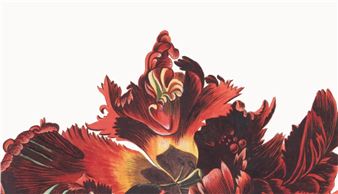John Henderson: Enchaînement
Perrotin is pleased to present encha├«nement, John HendersonÔÇÖs third exhibition in New York, showcasing new photographs, paintings, and gypsum casts.
Each of the works presented here begins with a gesture. Whether a photographic snapshot or a stretched canvas, John Henderson subjects his materials to a series of maneuvers, material translations, and technological dislocations that render them anew. In Flowers, a body of work that builds from commercially printed photographs, the evidence of such gestures is particularly pronounced, bringing to mind Richard SerraÔÇÖs well known, 1967 Verb List: to fold, to rotate, to flip, to draw, to paint, to paste, to scan, to print, to frame. The final work is the result of a host of manipulative processes, becoming its own form of archiveÔÇöan accumulation of HendersonÔÇÖs dance of materials. To describe this process, we might use the French word encha├«nement, literally a ÔÇ£chaining together,ÔÇØ a dance term that refers to a linked sequence of steps or gestures. In order to see HendersonÔÇÖs works, it helps to think of them in this wayÔÇönot as fixed or static conglomerations, but in relation to the mobile and temporal logic of performance. Each work is the result of a pas de deux between the artist and materials, rehearsed again and again against the backdrop of HendersonÔÇÖs studio-as-stage.
This practice marks a logical and intriguing elaboration of SerraÔÇÖs cataloguing of disparate actions. For Henderson, canonical operations of the history of abstract painting offer up an array of readymade gestures and motifsÔÇöthe expressionist brushstroke, the appropriated image, the monochrome, the gridÔÇömoves waiting to be reenacted (performed) and reimagined or dislodged through an encha├«nement of material displacements. In a selection of gypsum casts, exaggeratedly impasto-ed gestural paintings are transformed into cast plaster, producing a ghostly topography of white that becomes the freighted grounds for new painting. The faux tabula rasa performs a double dislocationÔÇöof HendersonÔÇÖs hand as well as those of his painterly predecessors. As a result, the final works frustrate our ability to locate a point of origin. Here, as in many of HendersonÔÇÖs works, his process follows a looped rather than linear development: works that begin as paintings are transformed into sculpture only to be made paintings once again.

Recommended for you
Perrotin is pleased to present encha├«nement, John HendersonÔÇÖs third exhibition in New York, showcasing new photographs, paintings, and gypsum casts.
Each of the works presented here begins with a gesture. Whether a photographic snapshot or a stretched canvas, John Henderson subjects his materials to a series of maneuvers, material translations, and technological dislocations that render them anew. In Flowers, a body of work that builds from commercially printed photographs, the evidence of such gestures is particularly pronounced, bringing to mind Richard SerraÔÇÖs well known, 1967 Verb List: to fold, to rotate, to flip, to draw, to paint, to paste, to scan, to print, to frame. The final work is the result of a host of manipulative processes, becoming its own form of archiveÔÇöan accumulation of HendersonÔÇÖs dance of materials. To describe this process, we might use the French word encha├«nement, literally a ÔÇ£chaining together,ÔÇØ a dance term that refers to a linked sequence of steps or gestures. In order to see HendersonÔÇÖs works, it helps to think of them in this wayÔÇönot as fixed or static conglomerations, but in relation to the mobile and temporal logic of performance. Each work is the result of a pas de deux between the artist and materials, rehearsed again and again against the backdrop of HendersonÔÇÖs studio-as-stage.
This practice marks a logical and intriguing elaboration of SerraÔÇÖs cataloguing of disparate actions. For Henderson, canonical operations of the history of abstract painting offer up an array of readymade gestures and motifsÔÇöthe expressionist brushstroke, the appropriated image, the monochrome, the gridÔÇömoves waiting to be reenacted (performed) and reimagined or dislodged through an encha├«nement of material displacements. In a selection of gypsum casts, exaggeratedly impasto-ed gestural paintings are transformed into cast plaster, producing a ghostly topography of white that becomes the freighted grounds for new painting. The faux tabula rasa performs a double dislocationÔÇöof HendersonÔÇÖs hand as well as those of his painterly predecessors. As a result, the final works frustrate our ability to locate a point of origin. Here, as in many of HendersonÔÇÖs works, his process follows a looped rather than linear development: works that begin as paintings are transformed into sculpture only to be made paintings once again.
Artists on show
Contact details















